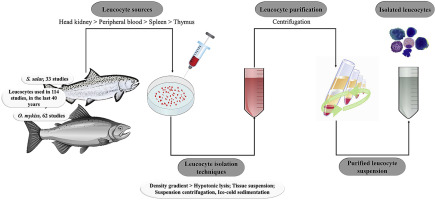Fish & Shellfish Immunology ( IF 4.1 ) Pub Date : 2019-10-08 , DOI: 10.1016/j.fsi.2019.10.006 Ronald Lulijwa , Andrea C. Alfaro , Fabrice Merien , Jill Meyer , Tim Young

|
Evaluating studies over the past almost 40 years, this review outlines the current knowledge and research gaps in the use of isolated leucocytes in salmonid immunology understanding. This contribution focuses on the techniques used to isolate salmonid immune cells and popular immunological assays. The paper also analyses the use of leucocytes to demonstrate immunomodulation following dietary manipulation, exposure to physical and chemical stressors, effects of pathogens and parasites, vaccine design and application strategies assessment. We also present findings on development of fish immune cell lines and their potential uses in aquaculture immunology. The review recovered 114 studies, where discontinuous density gradient centrifugation (DDGC) with Percoll density gradient was the most popular leucocyte isolation method. Fish head kidney (HK) and peripheral blood (PB) were the main sources of leucocytes, from rainbow trout (Oncorhynchus mykiss) and Atlantic salmon (Salmo salar). Phagocytosis and respiratory burst were the most popular immunological assays. Studies used isolated leucocytes to demonstrate that dietary manipulations enhance fish immunity, while chemical and physical stressors suppress immunity. In addition, parasites, and microbial pathogens depress fish innate immunity and induce pro-inflammatory cytokine gene transcripts production, while vaccines enhance immunity. This review found 10 developed salmonid cell lines, mainly from S. salar and O. mykiss HK tissue, which require fish euthanisation to isolate. In the face of high costs involved with density gradient reagents, the application of hypotonic lysis in conjunction with mico-volume blood methods can potentially reduce research costs, time, and using nonlethal and ethically flexible approaches. Since the targeted literature review for this study retrieved no metabolomics study of leucocytes, indicates that this approach, together with traditional technics and novel flow cytometry could help open new opportunities for in vitro studies in aquaculture immunology and vaccinology.
中文翻译:

鲑鱼免疫学的进展:淋巴组织和外周血白细胞分离和应用的方法和技术综述
在对过去近40年的研究进行评估时,本综述概述了在鲑鱼免疫学理解中使用分离的白细胞的当前知识和研究差距。该贡献集中于用于分离鲑鱼免疫细胞的技术和流行的免疫测定。本文还分析了白细胞的使用,以证明饮食控制,暴露于物理和化学应激源,病原体和寄生虫的影响,疫苗设计和应用策略评估后的免疫调节。我们还介绍了鱼类免疫细胞系的发展及其在水产养殖免疫学中的潜在用途的发现。该评论恢复了114项研究,其中采用Percoll密度梯度的不连续密度梯度离心(DDGC)是最流行的白细胞分离方法。Oncorhynchus mykiss和大西洋鲑(Salmo salar)。吞噬作用和呼吸爆发是最流行的免疫学检测方法。研究使用分离的白细胞来证明饮食控制可增强鱼类的免疫力,而化学和物理应激源则可抑制免疫力。此外,寄生虫和微生物病原体会降低鱼类的先天免疫力,并诱导促炎性细胞因子基因转录产物的产生,而疫苗则增强免疫力。这项审查发现了10种发达的鲑鱼细胞系,主要来自S. salar和O. mykissHK组织,需要对鱼类进行安乐死才能分离。面对与密度梯度试剂相关的高成本,将低渗裂解与微体积血液方法结合使用可潜在地降低研究成本,时间,并采用非致命性和符合伦理道德的灵活方法。由于该研究的针对性文献综述未检索到白细胞的代谢组学研究,因此表明该方法与传统技术和新颖的流式细胞术一起可为水产养殖免疫学和疫苗学的体外研究提供新的机会。































 京公网安备 11010802027423号
京公网安备 11010802027423号